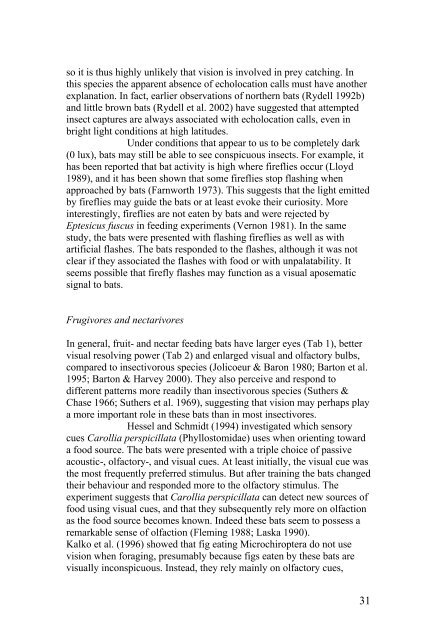Vision in echolocating bats - Fladdermus.net
Vision in echolocating bats - Fladdermus.net
Vision in echolocating bats - Fladdermus.net
Create successful ePaper yourself
Turn your PDF publications into a flip-book with our unique Google optimized e-Paper software.
so it is thus highly unlikely that vision is <strong>in</strong>volved <strong>in</strong> prey catch<strong>in</strong>g. In<br />
this species the apparent absence of echolocation calls must have another<br />
explanation. In fact, earlier observations of northern <strong>bats</strong> (Rydell 1992b)<br />
and little brown <strong>bats</strong> (Rydell et al. 2002) have suggested that attempted<br />
<strong>in</strong>sect captures are always associated with echolocation calls, even <strong>in</strong><br />
bright light conditions at high latitudes.<br />
Under conditions that appear to us to be completely dark<br />
(0 lux), <strong>bats</strong> may still be able to see conspicuous <strong>in</strong>sects. For example, it<br />
has been reported that bat activity is high where fireflies occur (Lloyd<br />
1989), and it has been shown that some fireflies stop flash<strong>in</strong>g when<br />
approached by <strong>bats</strong> (Farnworth 1973). This suggests that the light emitted<br />
by fireflies may guide the <strong>bats</strong> or at least evoke their curiosity. More<br />
<strong>in</strong>terest<strong>in</strong>gly, fireflies are not eaten by <strong>bats</strong> and were rejected by<br />
Eptesicus fuscus <strong>in</strong> feed<strong>in</strong>g experiments (Vernon 1981). In the same<br />
study, the <strong>bats</strong> were presented with flash<strong>in</strong>g fireflies as well as with<br />
artificial flashes. The <strong>bats</strong> responded to the flashes, although it was not<br />
clear if they associated the flashes with food or with unpalatability. It<br />
seems possible that firefly flashes may function as a visual aposematic<br />
signal to <strong>bats</strong>.<br />
Frugivores and nectarivores<br />
In general, fruit- and nectar feed<strong>in</strong>g <strong>bats</strong> have larger eyes (Tab 1), better<br />
visual resolv<strong>in</strong>g power (Tab 2) and enlarged visual and olfactory bulbs,<br />
compared to <strong>in</strong>sectivorous species (Jolicoeur & Baron 1980; Barton et al.<br />
1995; Barton & Harvey 2000). They also perceive and respond to<br />
different patterns more readily than <strong>in</strong>sectivorous species (Suthers &<br />
Chase 1966; Suthers et al. 1969), suggest<strong>in</strong>g that vision may perhaps play<br />
a more important role <strong>in</strong> these <strong>bats</strong> than <strong>in</strong> most <strong>in</strong>sectivores.<br />
Hessel and Schmidt (1994) <strong>in</strong>vestigated which sensory<br />
cues Carollia perspicillata (Phyllostomidae) uses when orient<strong>in</strong>g toward<br />
a food source. The <strong>bats</strong> were presented with a triple choice of passive<br />
acoustic-, olfactory-, and visual cues. At least <strong>in</strong>itially, the visual cue was<br />
the most frequently preferred stimulus. But after tra<strong>in</strong><strong>in</strong>g the <strong>bats</strong> changed<br />
their behaviour and responded more to the olfactory stimulus. The<br />
experiment suggests that Carollia perspicillata can detect new sources of<br />
food us<strong>in</strong>g visual cues, and that they subsequently rely more on olfaction<br />
as the food source becomes known. Indeed these <strong>bats</strong> seem to possess a<br />
remarkable sense of olfaction (Flem<strong>in</strong>g 1988; Laska 1990).<br />
Kalko et al. (1996) showed that fig eat<strong>in</strong>g Microchiroptera do not use<br />
vision when forag<strong>in</strong>g, presumably because figs eaten by these <strong>bats</strong> are<br />
visually <strong>in</strong>conspicuous. Instead, they rely ma<strong>in</strong>ly on olfactory cues,<br />
31


